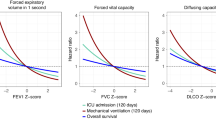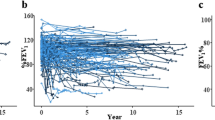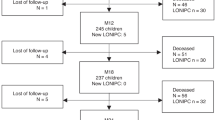Abstract
The Hematopoietic Cell Transplantation-specific Comorbidity Index (HCT-CI) is used to counsel patients regarding the risk of transplantation and selection of conditioning regimens. Pulmonary disease, most frequently demonstrated by a decreased diffusion capacity of carbon monoxide (DLCO), is the most prevalent comorbidity captured by the HCT-CI. The HCT-CI was validated using the Dinakara method for adjusting DLCO for Hb, but our institution and others utilize the Cotes method. The purpose of this study was to determine the impact of using the Cotes method rather than the Dinakara method on the HCT-CI score. We reviewed pre-transplant pulmonary function tests in 73 patients who underwent allogeneic hematopoietic SCT. Patients were stratified into low, intermediate or high-risk groups based on HCT-CI scores of 0, 1–2 or ⩾3, respectively. We found that compared with the Dinakara method, the Cotes method increased the HCT-CI score in 45% of patients and resulted in total HCT-CI scores predictive of higher non-relapse mortality in 33% of patients. These results indicate that if an institution uses the Cotes method to adjust DLCO for Hb, their patients may be counseled to expect a higher risk of mortality than is actually predicted by the HCT-CI, and may be excluded from transplantation. Therefore, unless the HCT-CI is validated using other methods for correcting DLCO for Hb, the Dinakara method should be used.
This is a preview of subscription content, access via your institution
Access options
Subscribe to this journal
Receive 12 print issues and online access
$259.00 per year
only $21.58 per issue
Buy this article
- Purchase on Springer Link
- Instant access to full article PDF
Prices may be subject to local taxes which are calculated during checkout
Similar content being viewed by others
References
Sorror ML, Maris MB, Storb R, Baron F, Sandmaier BM, Maloney DG et al. Hematopoietic cell transplantation (HCT)-specific comorbidity index: a new tool for risk assessment before allogeneic HCT. Blood 2005; 106: 2912–2919.
Charlson ME, Pompei P, Ales KL, MacKenzie CR . A new method of classifying prognostic comorbidity in longitudinal studies: development and validation. J Chronic Dis 1987; 40: 373–383.
Kerbauy DM, Chyou F, Gooley T, Sorror ML, Scott B, Pagel JM et al. Allogeneic hematopoietic cell transplantation for chronic myelomonocytic leukemia. Biol Blood Marrow Transplant 2005; 11: 713–720.
Sorror ML, Sandmaier BM, Storer BE, Maris MB, Baron F, Maloney DG et al. Comorbidity and disease status based risk stratification of outcomes among patients with acute myeloid leukemia or myelodysplasia receiving allogeneic hematopoietic cell transplantation. J Clin Oncol 2007; 25: 4246–4254.
Boehm A, Sperr WR, Leitner G, Worel N, Oehler L, Jaeger E et al. Comorbidity predicts survival in myelodysplastic syndromes or secondary acute myeloid leukaemia after allogeneic stem cell transplantation. Eur J Clin Invest 2008; 38: 945–952.
Sorror ML, Storer BE, Maloney DG, Sandmaier BM, Martin PJ, Storb R . Outcomes after allogeneic hematopoietic cell transplantation with nonmyeloablative or myeloablative conditioning regimens for treatment of lymphoma and chronic lymphocytic leukemia. Blood 2008; 111: 446–452.
Farina L, Bruno B, Patriarca F, Spina F, Sorasio R, Morelli M et al. The hematopoietic cell transplantation comorbidity index (HCT-CI) predicts clinical outcomes in lymphoma and myeloma patients after reduced-intensity or non-myeloablative allogeneic stem cell transplantation. Leukemia 2009; 23: 1131–1138.
Pollack SM, Steinberg SM, Odom J, Dean RM, Fowler DH, Bishop MR . Assessment of the hematopoietic cell transplantation comorbidity index in non-Hodgkin lymphoma patients receiving reduced-intensity allogeneic hematopoietic stem cell transplantation. Biol Blood Marrow Transplant 2009; 15: 223–230.
Pavlu J, Kew AK, Taylor-Roberts B, Auner HW, Marin D, Olavarria E et al. Optimizing patient selection for myeloablative allogeneic hematopoietic cell transplantation in chronic myeloid leukemia in chronic phase. Blood 2010; 115: 4018–4020.
Sorror ML, Giralt S, Sandmaier BM, De Lima M, Shahjahan M, Maloney DG et al. Hematopoietic cell transplantation specific comorbidity index as an outcome predictor for patients with acute myeloid leukemia in first remission: combined FHCRC and MDACC experiences. Blood 2007; 110: 4606–4613.
Sorror ML, Sandmaier BM, Storer BE, Franke GN, Laport GG, Chauncey TR et al. Long-term outcomes among older patients following nonmyeloablative conditioning and allogeneic hematopoietic cell transplantation for advanced hematologic malignancies. JAMA 2011; 306: 1874–1883.
Sorror M, Storer B, Sandmaier BM, Maloney DG, Chauncey TR, Langston A et al. Hematopoietic cell transplantation-comorbidity index and Karnofsky performance status are independent predictors of morbidity and mortality after allogeneic nonmyeloablative hematopoietic cell transplantation. Cancer 2008; 112: 1992–2001.
Sorror ML, Storer BE, Sandmaier BM, Maris M, Shizuru J, Maziarz R et al. Five-year follow-up of patients with advanced chronic lymphocytic leukemia treated with allogeneic hematopoietic cell transplantation after nonmyeloablative conditioning. J Clin Oncol 2008; 26: 4912–4920.
Birninger N, Bornhäuser M, Schaich M, Ehninger G, Schetelig J . The hematopoietic cell transplantation-specific comorbidity index fails to predict outcomes in high-risk aml patients undergoing allogeneic transplantation-investigation of potential limitations of the index. Biol Bloodd Marrow Transplant 2011; 17: 1822–1832.
Guilfoyle R, Demers A, Bredeson C, Richardson E, Rubinger M, Szwajcer D et al. Performance status, but not the hematopoietic cell transplantation comorbidity index (HCT-CI), predicts mortality at a Canadian transplant center. Bone Marrow Transplant 2009; 43: 133–139.
Terwey TH, Hemmati PG, Martus P, Dietz E, Vuong LG, Massenkeil G et al. A modified EBMT risk score and the hematopoietic cell transplantation-specific comorbidity index for pre-transplant risk assessment in adult acute lymphoblastic leukemia. Haematologica 2010; 95: 810–818.
Artz AS, Wickrema A, Dinner S, Godley LA, Kocherginsky M, Odenike O et al. Pretreatment C-reactive protein is a predictor for outcomes after reduced-intensity allogeneic hematopoietic cell transplantation. Biol Blood Marrow Transplant 2008; 14: 1209–1216.
Xhaard A, Porcher R, Chien JW, de Latour RP, Robin M, Ribaud P et al. Impact of comorbidity indexes on non-relapse mortality. Leukemia 2008; 22: 2062–2069.
Sorror ML Personal Communication. In 2012.
Cotes JE, Dabbs JM, Elwood PC, Hall AM, McDonald A, Saunders MJ . Iron-deficiency anaemia: its effect on transfer factor for the lung (diffusiong capacity) and ventilation and cardiac frequency during sub-maximal exercise. Clin Sci 1972; 42: 325–335.
Dinakara P, Blumenthal WS, Johnston RF, Kauffman LA, Solnick PB . The effect of anemia on pulmonary diffusing capacity with derivation of a correction equation. Am Rev Respir Dis 1970; 102: 965–969.
Macintyre N, Crapo RO, Viegi G, Johnson DC, van der Grinten CPM, Brusasco V et al. Standardisation of the single-breath determination of carbon monoxide uptake in the lung. Eur Respir J 2005; 26: 720–735.
Crapo RO, Morris AH . Standardized single breath normal values for carbon monoxide diffusing capacity. Am Rev Respir 1981; 123: 185–189.
Rodríguez-Roisin R, Roca J, Grañena A, Agustí AG, Marín P, Rozman C . Lung function in allogeneic bone marrow transplantation recipients. Eur Respir J 1989; 2: 359–365.
Marrades RM, Diaz O, Roca J, Campistol JM, Torregrosa JV, Barberà JA et al. Adjustment of DLCO for hemoglobin concentration. Am J Respir Crit Care Med 1997; 155: 236–241.
Acknowledgements
We thank Laura Kunde for her assistance in obtaining pulmonary function testing data.
Author information
Authors and Affiliations
Corresponding author
Ethics declarations
Competing interests
The authors declare no conflict of interest.
Rights and permissions
About this article
Cite this article
Coffey, D., Pollyea, D., Myint, H. et al. Adjusting DLCO for Hb and its effects on the Hematopoietic Cell Transplantation-specific Comorbidity Index. Bone Marrow Transplant 48, 1253–1256 (2013). https://doi.org/10.1038/bmt.2013.31
Received:
Revised:
Accepted:
Published:
Issue Date:
DOI: https://doi.org/10.1038/bmt.2013.31
Keywords
This article is cited by
-
Decline of forced expiratory volume in 1 s after allogeneic hematopoietic cell transplantation is a good indicator for pulmonary damage and is associated with busulfan use
International Journal of Hematology (2019)



